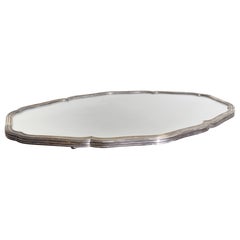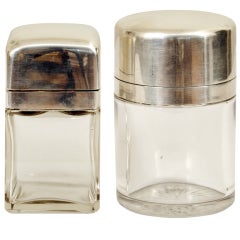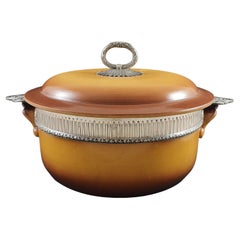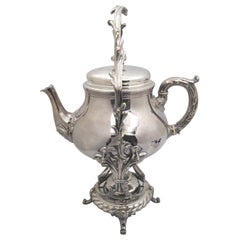ROBUCK Sterling Silver
2
to
2
2
2
2
1
1
1
1
1
1
2
2
1
2
1
Continental Rococo Style Silver Plate & Mirrored Plateau, early 20th century
Located in Atlanta, GA
Of classical Rococo form with a scalloped edges, retaining original mirror plate, raised on small feet
Category
Antique Early 1900s European Rococo Sterling Silver
Materials
Silver
Pair of 19th Century French Glass and Sterling Silver Vanity Receptacles
Located in Atlanta, GA
Each having a hinged top above a glass container complete with glass stopper, silver marks.
Cylinder measurements: Height: 4 in., diameter: 2.5 in,
cube measurements: Height: 3.7...
Category
Antique 19th Century French Neoclassical Sterling Silver
Materials
Silver
Related Items
19th French Terracotta and Sterling Silver Vegetable Dish
Located in Saint-Ouen, FR
Terracotta and Sterling Silver vegetable
Decorated with a frieze of pearls, foliage and foliage
Hallmarked Minerva 1st title for 950...
Category
Antique 1880s French Sterling Silver
Materials
Sterling Silver
Christofle Silver Plate Kettle on Stand in Rococo Style
By Christofle
Located in New York, NY
Christofle silver plated kettle on stand in ornate Rococo style with swirling natural motifs. The stand, which has 4 legged feet, measures an impr...
Category
Early 20th Century French Rococo Sterling Silver
Materials
Silver Plate
Early 20th Century Italian Sterling Silver Chalice
Located in Casale Monferrato, IT
Italian sterling silver Chalice finely embossed and chiselled 800 punch at the base. cup in golden bath. Excellent condition with its original packaging.
Category
Vintage 1930s Italian Sterling Silver
Materials
Silver
Antique Early 20th Century Sterling Silver Flask
Located in Braintree, GB
Antique Early 20th century sterling silver flask.
Made in Europe, most likely Spain, Circa 1920-1930's.
Hallmarked with a star, Spanish silver hallmark.
X-Ray Tested Confirmed ...
Category
Vintage 1910s Spanish Sterling Silver
Materials
Sterling Silver
19th Century Gorham Art Nouveau Sterling Silver Vanity Set, 7 Pieces
By Gorham
Located in Vero Beach, FL
19th century Gorham Art Nouveau sterling silver Vanity set, 7 pieces.
This stunning Art Nouveau sterling silver set is imaginatively created by Gorham. Each piece, as part of the matching set, abounds in glorious Art Nouveau embossed features including putti and foliate scrolls among numerous strewn floral embellishments. The set consists of seven fine pieces, all “sterling” serial numbered pieces are marked with the Gorham hallmarks. This English dresser set is comprised of a large hand mirror...
Category
Antique 19th Century English Art Nouveau Vanities
Materials
Sterling Silver
Antique Sterling Silver Tiffany & Co Hand Mirror Early 20th Century
By Tiffany & Co.
Located in London, GB
This is a wonderful antique Edwardian sterling silver hand-mirror with marks for 925 sterling silver, the maker's mark of the renowned silversmiths Tiffany & Co., and Circa 1900 in d...
Category
Antique Early 1900s Edwardian Sterling Silver
Materials
Sterling Silver
19th Century Italian Sterling Silver Madonna, circa 1830
Located in Milano, IT
Embossed and engraved silver plaque
La Madonna del lago (The Madonna of the Lake)
Probably Milan, post 1824
Brass frame
It measures 16.14 in x 13.85 in (41 x 35.2 cm) and it weighs 10.357 pounds (4.698 g): silver 1.31 pounds (598 g) + brass 9.03 pounds (4.100 g)
State of conservation: some abrasions on the bottom. The frame is old, but not original.
The plaque is made up of a sheet of embossed and engraved silver, and held in a solid brass frame. It depicts the “Madonna del lago” – “Madonna of the Lake” - (the Madonna with Child and San Giovannino) by Marco d'Oggiono (Oggiono, 1474 circa - Milan, 1524 circa), while changing only the background landscape. Almost certainly the subject reproduced in the plaque was taken from a famous engraving by Giuseppe Longhi (Monza, 1766 - Milan, 1831), one of the greatest engravers of his era.
The silver is unmarked, probably because originally the Madonna was due to be exposed in a church: sometimes precious metals destined for worship and liturgical use would be exempted from payment and were, therefore, not marked.
It is very likely that the plaque was made in Milan because in this city in 1824 the engraving by Giuseppe Longhi was made and printed. In addition, in Milan, the alleged lost painting by Leonardo da Vinci in his Milanese period (1482-1500) would be produced; this is the painting from which Marco d'Oggiono took his version.
The painting
Marco d?Oggiono was one of Leonardo da Vinci's most brilliant students and collaborators (D. Sedini, Marco d’Oggiono, tradizione e rinnovamento in Lombardia tra Quattrocento e Cinquecento, Roma 1989, pp. 151-153, n. 56; p. 225, n. 124, with previous bibliography). His style reflects in every way that of the Tuscan Maestro, so much so that he was the one who executed some copies of da Vinci's paintings. The execution of the “Madonna del Lago” probably draws inspiration from a lost painting by the Maestro, created while he was living in Milan (1482-1500). There are many similarities with other works by Leonardo such as the “Vergine delle rocce” or the “Vergine con il Bambino e San Giovannino, Sant’Anna e l’Agnello”.
The painting, from which the drawing and then the famous engraving were taken, is found today at the M&G Museum of Bob Jones University in Greenville, South Carolina, where it came to rest after the sale of the Harrington Collection in London in 1917.
The work appears in the inventories of the collection of Napoleon and Joséphine Bonaparte at the castle of Malmaison, before 1809.
The Malmaison building was born and developed in the 17th and 18th centuries. In the 18th century it belonged to Jacques-Jean Le Coulteux du Molay, a wealthy banker. Later, during the Directory, Joséphine Bonaparte de Beauharnais bought it on April 21st, 1799, but settled at the castle definitively only after her husband separated from her in 1809. She remained there until 1814, the year of her death. When Joséphine died, the estate passed to her son Eugène de Beauharnais, who moved to Munich with his whole family in 1815, bringing with him the collection of paintings he inherited from his mother. Eugène died in 1824 and his wife Augusta of Bavaria (von Bayern), unable to keep it, in 1828 sold the Malmaison to the Swedish banker Jonas-Philip Hagerman.
It is likely that in this period Augusta also sold part of the paintings inherited from her husband, including the “Madonna del Lago”. This painting then came into the possession of Leicester Stanhope, fifth Earl of Harrington (1784 - 1862) and then was passed down to his descendants.
In 1917, at the death of Charles, eighth Earl of Harrington, his brother Dudley inherited the title and properties and he put up a part of his collections for sale. Among these, precisely, the painting by Marco d'Oggiono was to be found.
On the occasion of that auction the painting was presented as a work by Cesare da Sesto, by virtue of a handwritten note by the Countess of Harrington on the back of the table. However, already in 1857, the German critic Gustav Waagen had identified Marco d'Oggiono as the author of the painting, then exhibited in the dining room of Harrington House in London (Treasures of Art in Great Britain, in 4 volumes, London, 1854 and 1857).
The engraving
Giuseppe Longhi was one of the most renowned engravers in Italy between the end of the 18th century and the first quarter of the 19th century.
In 1824 Giuseppe Longhi, based on a design by Paolo Caronni, made a famous engraving of the painting of Marco d?Oggiono. The activity of Longhi was then at the peak of his notoriety, enough to earn him very substantial commissions; it is not risky to suppose that some of his successful engravings were also reproduced using other means: in our case in silver. (A. Crespi, a cura di, Giuseppe Longhi 1766–1831 e Raffaello Morghen...
Category
Antique 1820s Italian Neoclassical Sterling Silver
Materials
Sterling Silver, Brass
Early 20th Century Antique Tiffany & Co. Sterling Silver Porringer
By Tiffany & Co.
Located in Soquel, CA
Early 20th Century Antique Tiffany & Co. Sterling Silver Porringer
Tiffany & Co. 10 ounce porringer, sterling silver, dated 1907-1938. Stamped on verso.
Category
Early 20th Century American Late Victorian Sterling Silver
Materials
Sterling Silver
Unger Sterling Silver Early 20th Century Bowl in Art Nouveau Style
By Unger Brothers
Located in New York, NY
Unger Brothers, sterling silver bowl in Art Nouveau style with a rim richly adorned with tri-dimensional natural motifs including sculptural roses. It measures 10 1/4'' in diameter by 2 7/8'' in height, weighs 10.3 troy ounces, and bears hallmarks and an engraved monogram at the center as shown.
Unger Bros. or Unger Brothers (1872–1910) was a jewelry company in Newark, New Jersey, best known for their sterling silver Art Nouveau designs. The company was established by five sons from a German immigrant family. The oldest founded a jewelry business between 1870-1872 and began the manufacture of sterling silver items in 1878. Other sons gradually joined the firm, among them a silversmith and an engraver whose brother-in-law became the leading artistic designer. By 1901, the firm had just under 300...
Category
Early 20th Century American Art Nouveau Sterling Silver
Materials
Silver, Sterling Silver
19th Century French Sterling Silver Fish Servers Set of Two Pieces
By Noel & Durand
Located in Sofia, BG
19th century French sterling silver fish servers set of two pieces i original box.
Noel & Durand, Bijouterie or Fevrerie, Montpellier, France, circa 1...
Category
Antique Late 19th Century French Sterling Silver
Materials
Silver
19th century Sterling silver fruit bowl
By Fenton Brothers
Located in Chelmsford, GB
A superb sterling silver fruit bowl ,
It is a very decorative piece of silver with swag and ribbon decoration that really does catch the eye. The thick gauge of silver used gives it...
Category
Antique Early 1900s English Rococo Sterling Silver
Materials
Silver
Late 19th Century Pair of "King" Pattern Sterling Silver Spoons
By Dominick & Haff
Located in Chapel Hill, NC
Pair of "King" pattern sterling silver serving or table spoons, retailed by J.E. Caldwell & Co., late 19th century. Most probably by Dominick & Haff. Light design wear...
Category
Antique Late 19th Century American Aesthetic Movement Sterling Silver
Materials
Sterling Silver



